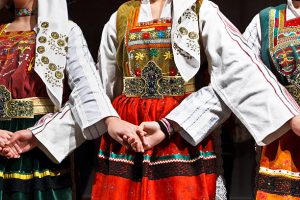Culture and people of Skiathos
Although Skiathos is an island with modern infrastructure for its visitors, it manages to preserve customs and traditions from centuries ago. And, in fact, it does not present most of them as an attraction, but has adapted them to the daily life of its residents and visitors.
The culinary traditions of Skiathos are another cornerstone of its culture, offering a window into the island’s history and lifestyle. The local cuisine is characterized by fresh, seasonal ingredients sourced from the land and sea. Dishes such as “spetsofai” (a spicy sausage and pepper stew) and “tsitsiravla” (tender shoots of wild pistachio trees pickled in vinegar) reflect the island’s culinary heritage, which combines simplicity with rich flavours. Olive oil, fresh vegetables, fish, and local cheeses feature prominently in Skiathian recipes, embodying the Mediterranean diet’s healthy and flavourful aspects.
Folk music and dance are vital expressions of Skiathos’ cultural identity, with traditional songs and dances passed down through generations. Music and dance performances are common at festivals and social gatherings, where the lyra and bouzouki often accompany dancers in a circle, performing steps that tell stories of love, life, and the sea. These art forms not only entertain but also foster a sense of belonging and continuity among the island’s residents.
The people of Skiathos, with their deep-seated sense of community and hospitality, are the true custodians of the island’s culture and traditions. Their dedication to preserving their heritage, while embracing the influx of visitors each year, has created a unique cultural landscape that is both welcoming and intriguing. The Skiathians’ love for their island is evident in their friendly demeanour, willingness to share their traditions, and the pride they take in their local customs and way of life.
The famous Skiathic costume

Women’s Skiathic clothing had a better luck and this because it was more beautiful and more valuable than the men’s but also because of the conservatism of those times. Women’s clothing consists of: petticoat, flannel, stockings, fur (looks like a small shirt, made of felt), babougli (vest with sleeves made of velvet fabric), kuzuka (velvet or stuffing vest, open in front with ornaments at the neck), kolovoli (petticoat), malina (underdress), girdle (always gold, seen outside the babougli), zonari (silk scarf tied in front) and boksa (large woolen fringed scarf worn in winter). The attire was accompanied by long earrings with tassels, bracelets, rings, brooches, the kulaina (a necklace made of a thin gold chain from which hung gold tassels).
Dancing and singing the Kamara
The most characteristic Skiathic song is “Kamara”, which is sung by the women wearing their official costume. This folk song is a variation of the haunted “Bridge of Arta”. Each verse is sung to the same tune, with the same repetitions and crooning.
This song is danced according to the dance of the same name after the second resurrection and on the feast of St. Georgiou.It is impressive that when the town of Skiathos was transferred to the Castle, “Kamara” was danced on the roof of the castle, while when they returned to the town again they sang it again
Halloween in Skiathos
In recent years, the customs of Halloween have been revived on the island with the support of the Municipality of Skiathos and the associations of the island. The carnival events like awarding of the best traditional costume, modern costume, treasure hunt, etc. they give the island’s residents the opportunity to have fun and go wild. Of course, throughout the events, music, dancing and wine could not be missing.
March 25 torchlight procession
The eothino and the torchlight are two customs that come from the years of the Turkish occupation and combine the resurrection of Christ with the resurrection of the race, paralleling the holy light on the one hand with the light of freedom on the other. Although they stopped being held for some years, in the 90s, the Women’s Association of Skiathos revived it and in recent years the Municipality of Skiathos has continued it in collaboration with the Spiritual Center of the Churches and the Hellenic Guidance Body.
Eothino means the celebratory awakening of the island and takes place on March 25th at 5 o’clock in the morning with the participation of the students of the 6th grade of the primary school. Hymns and hymns of the Church were sung in honor of the liberation of the nation.
The torchlight procession takes place in the evening at 8 o’clock and after they gather, in the past in the Primary school but now in the High School, they distribute candles and candles, the torchlight procession begins, with the students first lined up by class and the adults following behind, singing the same hymns as the euthinus.
Holy Thursday carols
The children of the island after the morning church and after taking part, go from house to house holding reed crosses decorated with rosemary, violets, roses, lilies and poppies and sing the carols of Maundy Thursday.
Good Friday
In Skiathos, Good Friday is a day of mourning and the custom requires the locals not to put a single bite in their mouths, and they also do not shake hands when they meet. As soon as it gets dark, the kids will
